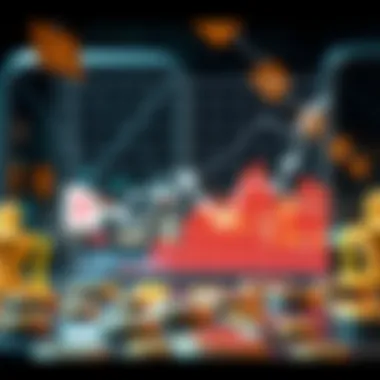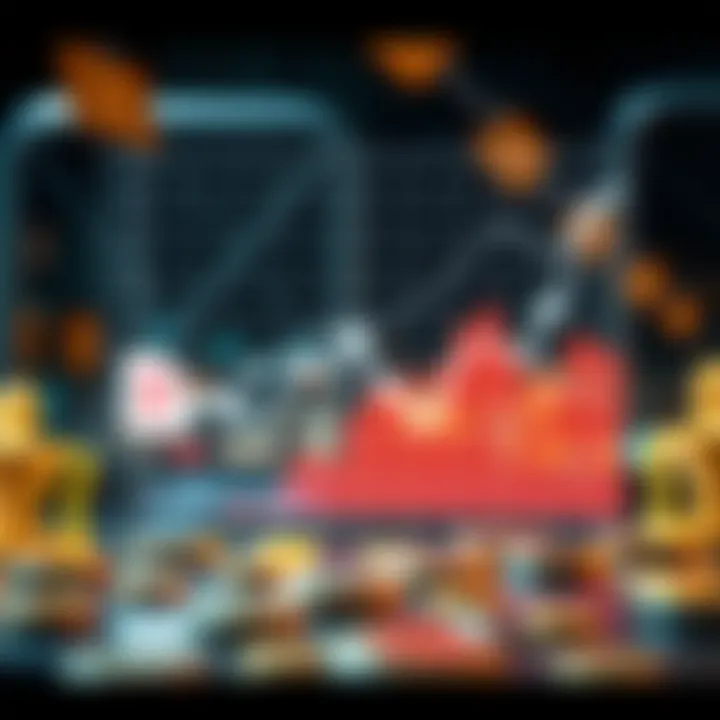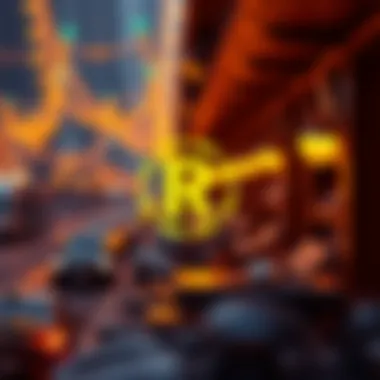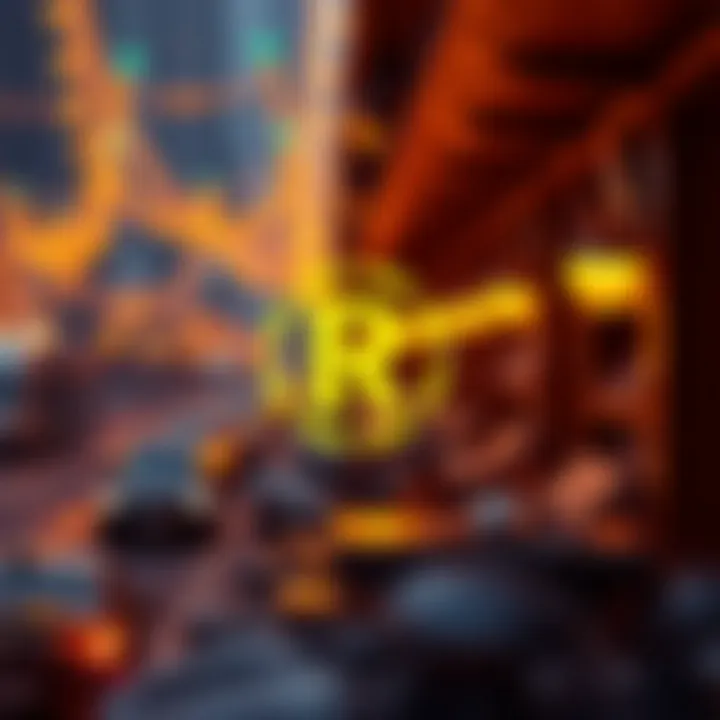Understanding Render Token Crypto: A Complete Guide


Intro
The world of cryptocurrency is vast, dynamic, and often overwhelming, especially for newcomers. However, within this expanse lies Render Token, a digital currency carved out of necessity in an era increasingly relying on digital content creation. This article aims to break down the complexities surrounding Render Token, guiding both investors and tech enthusiasts alike through its innovative underpinnings and practical uses.
By delving into blockchain technology and the unique attributes of Render Token, we will uncover its potential to shift how digital assets are synthesized and shared. Additionally, we will not shy away from exploring tangible applications, market trends, and insightful investment strategies. Understanding where Render Token stands in the larger cryptocurrency ecosystem is key, and this guide offers clarity for those keen on navigating this exciting terrain.
As we embark on this exploration, readers should be equipped to glean not only knowledge but also a deeper understanding of investments in Render Token and the technology that propels it forward.
Cryptocurrency Basics
Understanding Blockchain Technology
At the heart of Render Token’s essence sits blockchain technology, a platform that enables transparent and secure transactions without the need for intermediaries. This technology functions as a decentralized ledger, recording each transaction in a chronologically linked chain of data blocks. As this chain grows with every new transaction, it forms an immutable record that is accessible and verifiable by anyone in the network.
Intro to Render Token
In the rapidly evolving world of cryptocurrency, Render Token stands out as a noteworthy player. It touches on significant aspects of creativity and technology, aiming to make a real splash in how digital content is created and consumed. This guide breaks down the complexities of Render Token, making it accessible for anyone looking to grasp its nuances. Understanding this token is essential, not just for investors, but also for tech enthusiasts and educators who want to dive into the intersection of crypto and digital content creation.
Definition and Purpose
Render Token (RNDR) is a cryptocurrency designed to facilitate a decentralized network primarily focused on digital rendering services. Leveraging the power of blockchain, it allows users to monetize their graphic processing power, creating a marketplace for rendering tasks. For artists, animators, and game developers, this model offers a means to collaborate on projects more efficiently, reducing costs and speeding up the process. Essentially, Render Token aims to democratize access to powerful rendering resources that were historically expensive and accessible only to large studios or firms.
In practical terms, the purpose of Render Token spans various applications:
- Monetization of GPU Power: Users can earn RNDR tokens by providing their unused graphics processing unit power to help render projects.
- Cost-Efficiency in Rendering: By tapping into a broader network of contributors, the platform lowers the costs associated with traditional rendering solutions.
- Community Collaboration: It creates an ecosystem where creators can share resources and expertise without intermediaries, fostering innovation.
By understanding RNDR, stakeholders can better appreciate the potential shifts in the content creation landscape, emphasizing efficiency and collaboration like never before.
Historical Context
The inception of Render Token can be traced back to the growth of both blockchain technology and the increased demand for high-quality graphics rendering in the digital space. As cryptocurrencies gained traction around 2017, the interest in decentralized applications surged. It became apparent that bridging the gap between blockchain and creative industries could lead to groundbreaking developments.
The journey of Render Token has been influenced by several key milestones:
- 2017: The idea took shape as part of a broader recognition of blockchain's potential in diversifying revenue streams for digital creators.
- Initial Token Offering: Similar to many cryptocurrencies, RNDR was launched through an initial offering allowing early adopters to acquire tokens at a favorable rate.
- Community Building: Post-launch, the emphasis shifted to community engagement and partnerships, solidifying the platform's credibility and expanding its user base.
Understanding this historical context not only reflects the forces that shaped Render Token’s evolution but also illustrates its ongoing adaptation in response to technological advancements and market needs, making it an intriguing subject for further exploration.
The Technology Behind Render Token
The backbone of Render Token is its technological framework, which transforms how digital content is rendered and distributed. Embracing cutting-edge innovations, this framework not only optimizes processes but also fosters a new wave of collaboration and creativity across industries. Understanding these technologies is crucial to appreciate the potential impact of Render Token on the digital landscape.
Blockchain Fundamentals
To grasp the essence of Render Token's technology, one must start with blockchain. It serves as the underlying architecture that powers the entire network. Essentially, blockchain is a distributed ledger that maintains data integrity through a decentralized approach. Each transaction is recorded in blocks, which are then linked in chronological order. This creates a transparent and unalterable record of transactions.
The security and efficiency of blockchain make it an ideal platform for rendering processes. By eliminating the need for intermediaries, blockchain enhances trust and minimizes costs. In the art of digital content creation, this means that artists and developers can focus on their craft rather than dealing with cumbersome processes that were typical in traditional rendering systems.
Decentralized Rendering Process
How It Works
The decentralized rendering process of Render Token takes a revolutionary approach. Instead of relying on centralized servers that can bottleneck resources, the system distributes rendering tasks across a diverse network of nodes. This means, when a user submits a rendering job, it is encrypted and sent to multiple nodes to be processed simultaneously.
This method not only speeds up the rendering time significantly but also maximizes resource utilization. Each node can vary in capabilities, ranging from ordinary laptops to professional-grade servers, and all contribute to the rendering workload. The unique feature here is the ability to dynamically allocate processing power best suited for the task at hand, promoting efficiency and reducing costs for users. However, it still begs the question of reliability, as the performance can be inconsistent depending on the nodes involved.
Benefits of Decentralization
The benefits of a decentralized rendering network are numerous. Firstly, it enhances security by reducing vulnerability to single points of failure. In a traditional setup, a central server could be a target for hackers. With decentralized nodes, compromising one doesn’t affect the entire system.
Secondly, users can experience lower costs. This system allows creators to tap into under-utilized resources, democratizing access to high-quality rendering services that might be otherwise expensive if reliant on big firms. The unique feature of this model fosters collaboration across different creatives, enabling a community-driven approach to content creation where artists can contribute as they see fit and reap rewards.


Comparison with Traditional Rendering
When comparing decentralized rendering to traditional methods, the advantages become apparent. Traditional rendering usually requires substantial up-front investment in hardware and software, locking users into sometimes exorbitant ecosystems. In contrast, decentralized systems promote flexibility.
Users pay only for what they require, whether it's processing power, speed, or storage—scaling costs in line with specific needs rather than a fixed model. This adaptability is a key characteristic that empowers both amateur creators and seasoned professionals. However, there are downsides, such as potential latency issues and the complexity involved in tracking and compensating contributors within the network.
Technical Architecture
In delving deeper, understanding the technical architecture of Render Token reveals two critical components: network components and smart contracts.
Network Components
The network is composed of various nodes that all play specific roles in rendering tasks. These nodes range from submitters to providers, each carrying a unique responsibility within the ecosystem. This architecture fosters an intricate web of connectivity that allows seamless collaboration.
The key characteristic of these network components is their ability to adapt and scale based on demand. As more users join the network, it can absorb the additional rendering tasks without sacrificing performance. Such resilience is vital for ensuring that the platform remains reliable. However, it can require continuous upgrades and management to maintain optimal operation, posing logistical challenges in coordination.
Smart Contracts in Rendering
Smart contracts in Render Token act as automated agreements between parties. Upon a job submission, these contracts execute specific conditions, such as payment upon completion of rendering jobs. They facilitate trust without needing a middleman, providing efficiency in transactions.
This automated aspect of smart contracts reduces administrative overhead, allowing creators to focus on their work without worrying about manual compensation processes. However, their inflexibility can sometimes be a double-edged sword, as unexpected changes or disputes can be cumbersome to resolve. The rules are coded to specific conditions, and once activated, they operate autonomously, which can occasionally lead to unintended outcomes if the initial parameters are not well-defined.
In summary, the technology behind Render Token goes beyond mere buzzwords; it represents a potent shift in how digital content can be created and shared. By leveraging blockchain, decentralized processes, and technical innovations, it paves the way for a more collaborative and efficient future in digital content rendering.
Economic Aspects of Render Token
The economic landscape surrounding Render Token is a pivotal piece that helps delineate its potential impacts and benefits in the increasingly evolving world of digital currencies. By looking closely at the tokenomics, market performance, and investment considerations, one can glean insights into the viability of Render Token as a promising option, highlighting its practical applications and pitfalls.
Tokenomics Overview
Supply Mechanics
Understanding the supply dynamics of Render Token is critical as it lays the foundation for its valuation in the marketplace. The token operates on a capped supply model, meaning there's a limit to how many tokens can ever be created. This scarcity factor often contributes to increasing demand as the ecosystem grows. The key characteristic of this setup is that it inherently fosters value retention. The design is not just beneficial, but it aligns with classical economic principles, making it a popular choice among investors looking for deflationary assets.
A unique feature of its supply mechanics is the ability to burn tokens through certain transactions, reducing the total circulating supply over time. This mechanism can help to mitigate inflationary pressures and support price stability. However, potential disadvantages include the risk of over-restriction, where excessive token burning could limit the network's growth and functionalities.
Utility of the Token
The utility of Render Token extends beyond mere speculation; it's integral to the functionality of its platform. This token acts as a medium of exchange within the Render ecosystem, facilitating transactions for rendering services and providing a way to reward contributors. What makes this utility so appealing is its capacity to create a user-driven economy that caters to artists and developers alike.
A distinctive feature is that tokens can also be staked for governance, allowing users to partake in decision-making processes that shape the development of the platform. Such participatory models not only enhance community engagement but also provide users a sense of ownership. On the downside, users may find the staking lock-in periods less appealing, as these can limit liquidity in a volatile market.
Market Performance Analysis
Price Trends
Price trends of Render Token give a window into its market sentiment and investor confidence. Observing its historical performance provides critical insights into how it may react to future developments. A noteworthy characteristic is its relatively high volatility, typical in emerging cryptocurrencies, which presents both opportunities and risks. For instance, market reactions to significant technological upgrades often lead to substantial price fluctuations.
The unique feature to pay attention to here is the correlation of price trends with broader market movements, especially amid crypto market cycles. This relationship can aid investors in predicting future potential but can also expose them to heightened risks during downturns or bearish trends.
Market Capitalization Overview
Market capitalization is another essential aspect that illustrates the overall valuation of Render Token. By assessing its market cap, one can derive insights into its standing relative to other cryptocurrencies. A crucial characteristic of this metric is that it can reflect investor sentiment and the token's adoption level. For a token like Render, a growing market cap often signals increasing interest and faith in its underlying technology.
One notable component of market capitalization is its fluctuation based on trading volumes. This interconnection underscores the demand-supply balance within the crypto space, affecting how Render is perceived by potential investors. However, the volatility in trading volumes may sometimes skew market capitalization, making it an unreliable indicator at particular times.
Investment Considerations
Risk Factors
Investing in Render Token isn't without its pitfalls, and understanding the risk factors is essential for any savvy investor. One of the more significant risks involves technological vulnerabilities; as with any crypto, hacks or bugs can lead to substantial financial losses. This characteristic makes diligence in following developments and updates of the platform critical for investors.


Additionally, market sentiment can shift rapidly, influenced by various external factors like regulatory news or competition. Such fluctuations can also serve as warning signs, as rapid price adjustments could result in restricted liquidity and profit losses.
Potential Returns
On the flip side, potential returns with Render Token can be quite attractive, especially for early adopters. The growing integration of decentralized rendering solutions presents lucrative opportunities for investors. A defining characteristic of these potential returns is the ecosystem's scalability, enabling further market capture as demand expands.
What makes the potential returns more compelling is the current trajectory of the rendering market. As more creators turn towards decentralized solutions for their projects, Render Token stands to benefit significantly from increased token demand. However, investors must stay vigilant about market trends and technological advancements to capitalize on these opportunities effectively.
The economic dimensions of Render Token underscore the importance of thorough research and informed decision-making for investors aiming to navigate this complex landscape with greater assurance.
Use Cases of Render Token
The realm of cryptocurrency is often adorned with multiple concepts, but when it comes to practical application, the importance of Render Token shines through. By allowing users to harness decentralized rendering capabilities, it transforms the digital landscape in novel ways. Not only does Render Token empower creators, but it also brings forth a platform for collaboration that hasn’t been seen before in content production and distribution.
Content Creation and Distribution
Applications in Animation and Gaming
The applications of Render Token in animation and gaming is a goldmine waiting to be explored. A standout characteristic of this technology is its ability to distribute rendering tasks across a network of users. Traditional rendering approaches can be a bottleneck, often requiring powerful hardware and significant time, which can dampen creativity and innovation.
What makes these applications particularly enticing is their unique feature of cost-efficient processing. High-quality graphics and animations require not just immense creativity, but also substantial computational resources. With Render Token, the rendering workload can be shared among many users, leading to faster project completions without the high costs associated with conventional methods. This democratization of access fosters an environment where even smaller studios can compete against the giants in the industry.
On the flip side, while this model is advantageous, it's not without its downsides. Concerns about network reliability and variable computing power from different contributors can lead to potential inconsistencies in output quality. Nevertheless, the upside generally outweighs the drawbacks, marking a significant evolution for creators in these sectors.
Impacts on Film and Media
The impacts of Render Token on the film and media industry are both profound and telling. One of the key aspects here is streamlining collaboration amongst teams, regardless of geographic location. In a world where a film might be shot across continents, having a centralized rendering process can slow down workflows significantly. Render Token enables real-time rendering powered by contributors all over the globe, vastly improving production timelines.
The unique feature of this approach lies in its scalability. As a production grows, so does the need for computational power. Render Token allows studios to scale their resources up or down dynamically based on project demands. This adaptability is highly beneficial, especially when contending with tight deadlines, expansion of storytelling projects, or any unforeseen changes in creative direction.
However, the reliance on a decentralized network can introduce uncertainties; quality control remains a challenge. Each contributor must adhere to a certain standard, or the integrity of the final product can hang in the balance. Still, for many, the collaborative potential offered by Render Token makes it a compelling choice worth exploring.
Collaborative Projects
Decentralized Collaboration Opportunities
In exploring decentralized collaboration opportunities, the social and economic dynamics of how creative projects are conceived shift dramatically. A hallmark of Render Token’s framework is its ability to mitigate the need for intermediaries like studios or publishers, directly connecting creators with resources and audiences. This not only streamlines processes but also encourages a richer exchange of ideas.
The fundamental characteristic of these opportunities involves creating a shared space where creatives can come together to innovate and bring projects to life. The benefits here are tremendous; artists can leverage each other's strengths from different parts of the world, resulting in a genuinely eclectic blend of creativity.
That said, the hurdle remains the necessity for coordination and effective communication among participants. A lack of clear governance could lead to mismanagement or conflicts within a team. But when orchestrated well, the potential for impactful art is limitless.
Case Studies
Utilizing case studies to showcase the practical applications of Render Token highlights its usability within real-world scenarios. Examining specific projects can provide insights into how professionals are leveraging this technology to adapt to the ever-changing demands of digital content creation.
Indeed, these case studies reveal a key characteristic: flexibility. Many projects began with small teams and expanded significantly as more contributors joined the rendering network. This method of gradual scaling is not just beneficial; it serves as a testament to the advantages of embracing decentralization.
However, an inherent feature in these studies often points to varied experiences among users. While some projects thrived, others encountered difficulties. Analyzing these contrasts is as much a learning tool as any formal instruction. It encourages users to innovate and refine their approaches further.
Challenges and Limitations
In the evolving landscape of cryptocurrency, Render Token has positioned itself as a pioneer in decentralized rendering. However, like all innovations, it isn’t without its share of challenges and limitations. It is crucial to understand these aspects as they shape both the technology’s adoption and its real-world application.
Technical Barriers
Scalability Issues
One of the primary hurdles facing Render Token is scalability. Essentially, scalability refers to the system's ability to manage an increasing number of transactions or data without compromising performance. This is paramount in the realm of rendering, where high computational load can be the norm. Scalability becomes particularly critical when numerous users demand resources simultaneously.
The unique characteristic of scalability issues within Render Token is that it directly impacts the speed and efficiency of rendering tasks. If the network can’t handle a surge of users needing to complete their work, it could lead to delays that frustrate content creators. This creates a bottleneck, which signifies a downfall for any system aimed at efficiency. However, it also casts a light on potential innovations—solutions like layer-2 scaling can be explored to enhance performance.


Interoperability Challenges
Next in line are interoperability challenges. This term describes how effectively different systems, platforms, or technologies communicate and work together. For Render Token, interoperability is important because users may want to connect their digital assets across various platforms and protocols. Without seamless interoperability, users could feel constrained, leading to a fragmented ecosystem.
The key characteristic here is the lack of standardized protocols that could harmonize communication between diverse networks. This can slow adoption, as effective integration is essential for users who need a cohesive workflow. A unique feature of these challenges is the potential alienation of users who may find it easier to rely on existing centralized systems instead. While addressing interoperability could open doors to broader adoption, navigating the complexities of different technological infrastructures is no small feat.
Regulatory Environment
As Render Token captures attention, the landscape is likewise shaped by external factors, particularly government regulations. Understanding these regulatory frameworks becomes especially vital for investors and stakeholders alike, as they stand to influence market stability and long-term viability.
Government Regulations
Government regulations can significantly impact the functioning of cryptocurrencies. For Render Token, specific regulatory paradigms directly affect how the platform can operate. These regulations can dictate terms of use, what transactions are legal, or how users are taxed. A notable characteristic here is the ever-changing nature of these regulations, which can vary dramatically from one country to another.
Moreover, thorough consideration of these regulations brings forth challenges and opportunities alike. While stringent regulations could hinder growth and stifle innovation, they can also lend legitimacy to Render Token's operations, potentially attracting institutional investors. The dilemma lies in reconciling regulatory compliance with the decentralized ethos that underpins crypto technology.
Compliance Implications
Compliance implications delve into the legal responsibilities that the platform needs to uphold to align with government mandates. Constructing infrastructure that meets these compliance requirements is tedious but necessary. The key feature here is that failure to comply can lead to severe penalties or even banishment from certain markets, which can severely limit Render Token's operational scope.
On the flip side, ensuring compliance can bolster user confidence, creating a safer environment. This duality presents a balancing act—navigating compliance while maintaining the core principle of decentralization. To enhance attractiveness to investors, being compliant, transparent, and user-centric should remain priorities for Render Token as they chart their path forward.
Understanding challenges and limitations allows stakeholders to better navigate the complexities of emerging technologies like Render Token.
In summary, while the challenges and limitations facing Render Token may pose current obstacles, they also present opportunities for growth and innovation. By addressing scalability, interoperability, and regulatory issues head-on, Render Token can position itself to thrive in the competitive landscape of decentralized rendering.
The Future of Render Token
The future of Render Token presents a world ripe with possibilities. In an ever-evolving digital landscape, where content creation and distribution demand adaptability, Render Token positions itself as a pivotal technology. It not only promises to streamline graphics processing but also introduces new economic dynamics in the artistic sphere. As we assess its potential trajectory, it’s important to tackle market predictions alongside innovations that could redefine how we perceive and engage with digital content.
Market Predictions
When one ponders the future of Render Token, market predictions play a significant role in the overall assessment. Analysts suggest that the adoption of decentralized rendering could increase over the next few years, driven by demand for high-quality content and faster rendering times.
- Increased Adoption: As more artists and developers recognize the efficiencies provided by Render Token, their adoption is likely to surge. The shift from traditional rendering to a decentralized model offers both cost and time savings, an appealing prospect for many.
- Volatility and Growth: Like many cryptocurrencies, Render Token could experience fluctuations. However, industry trends indicate a bullish outlook—especially as gaming, animation, and virtual reality industries expand. If these sectors continue their upward trajectory, Render Token stands to benefit significantly.
- Integration with Emerging Technologies: Technologies such as artificial intelligence and machine learning may find synergy with Render Token, enhancing rendering capabilities. Such integrations could bolster market confidence and lead to increased investment.
"The only constant in the tech world is change, and those who adapt are the ones who thrive. Render Token seems well-positioned for just that—adaptation and growth."
Potential Innovations
As we look ahead, the potential innovations surrounding Render Token are nothing short of intriguing. With the canvas of digital content creation stretching wider every day, Render Token may pave the way for breakthroughs in various realms:
- Advances in Cloud Rendering: Future developments could lead to robust cloud-based rendering solutions, requiring less local storage and computing power. This shifts burdens away from individual artists, allowing them to focus on creativity rather than resource constraints.
- Collaborative Tools: Imagine environments where multiple artists collaborate in real time using Render Token. This concept could foster a new wave of creativity, where ideas flow freely across different disciplines—from video game graphics to animated films.
- Sustainability Features: As discussions around environmental impact gain momentum, Render Token has the chance to innovate in energy-efficient rendering. Utilizing less energy could attract environmentally conscious investors and creators alike, adding a layer of marketability.
Adoption and innovation are key drivers for the future of Render Token. When one considers its implications in various industries, it's clear that this technology is set to play an instrumental role in shaping the future of content creation.
Finale
In the ever-evolving landscape of digital currencies, Render Token emerges as a compelling player, particularly due to its unique approach to decentralized rendering. This conclusion section is essential because it ties together all the aspects we've discussed previously, offering clear guidance for investors, tech enthusiasts, and educators who seek to understand the mechanism and potential of Render Token.
Summarizing Key Insights
Throughout this article, various elements of Render Token have shown its significance in reshaping content creation and distribution. Here are the key insights that encapsulate its importance:
- Blockchain Empowered: Render Token utilizes blockchain to ensure transparency and security in rendering tasks, creating a trustworthy environment for creators and developers alike.
- Decentralization Advantage: Unlike traditional rendering services, which often depend heavily on centralized servers, Render Token facilitates a decentralized approach. This innovation not only increases efficiency but also brings down costs significantly.
- Robust Ecosystem: The tokenomics and utility of Render Token create a robust ecosystem that encourages participation from various stakeholders, fostering a community-driven model that enhances collaboration.
- Market Potential: The market performance analysis illustrates a growing interest and demand, suggesting that Render Token could be a worthwhile consideration for both short-term and long-term investors.
These insights highlight Render Token not just as a cryptocurrency but as a potential revolution in how we think about digital content creation and distribution.
Final Thoughts on Render Token
In closing, Render Token stands at a significant intersection of technology and creative industry needs. Its decentralized architecture can potentially level the playing field, providing opportunities for artists and developers who may not have access to the more established and costly rendering services. As we look ahead, one can’t ignore the potential innovations that might arise from this technology. The combination of community engagement, economic viability, and technological prowess bodes well for Render Token.
Investing in Render Token may not just offer financial returns but also align with a movement towards a more collaborative and accessible digital future. This prospective shift isn't merely about profit; it's about participating in a transformative phase of content creation. As it stands, the chance to be part of this shift is something to consider seriously.
In the rapidly changing world of digital assets, understanding tokens like Render is not just beneficial—it's necessary.
Overall, as we forge ahead into an increasingly interconnected and digital society, the role of Render Token and similar innovations is sure to be pivotal. By staying informed and engaged, investors and educators can better navigate this exciting landscape.







